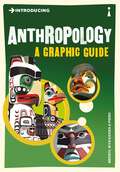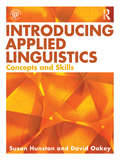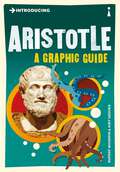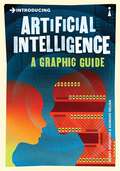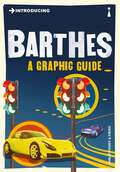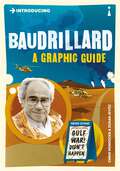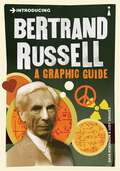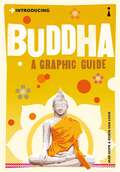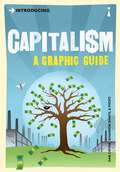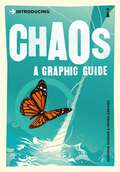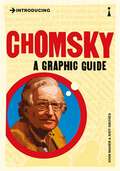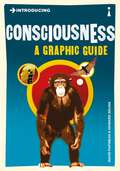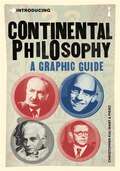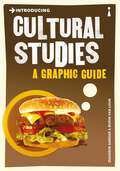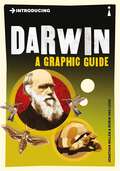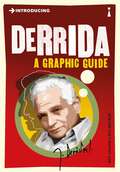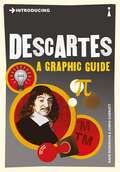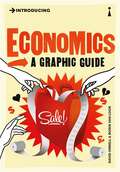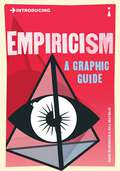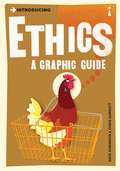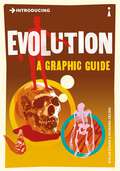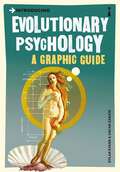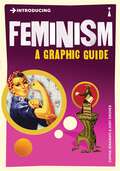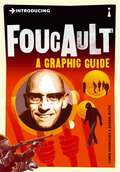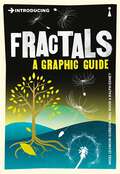- Table View
- List View
Introducing Anthropology: A Graphic Guide (Introducing...)
by Merryl Wyn-DavisAnthropology originated as the study of 'primitive' cultures. But the notion of 'primitive' exposes presumptions of 'civilized' superiority and the right of the West to speak for 'less evolved' others. With the fall of Empire, anthropology became suspect and was torn by dissension from within. Did anthropology serve as a 'handmaiden to colonialism'? Is it a 'science' created by racism to prove racism? Can it aid communication between cultures, or does it reinforce our differences? "Introducing Anthropology" is a fascinating account of an uncertain human science seeking to transcend its unsavoury history. It traces the evolution of anthropology from its genesis in Ancient Greece to its varied forms in contemporary times. Anthropology's key concepts and methods are explained, and we are presented with such big-name anthropologists as Franz Boas, Bronislaw Malinowski, E.E. Evans-Pritchard, Margaret Mead and Claude Levi-Strauss. The new varieties of self-critical and postmodern anthropologies are examined, and the leading question - of the impact of anthropology on non-Western cultures - is given centre-stage. "Introducing Anthropology" is lucid in its arguments, its good humour supported by apt and witty illustrations. This book offers a highly accessible invitation into anthropology.
Introducing Applied Linguistics (PDF): Concepts and Skills
by Susan Hunston David OakeyIntroducing Applied Linguistics provides in-depth coverage of key areas in the subject, as well as introducing the essential study skills needed for academic success in the field. Introducing Applied Linguistics: • is organised into two Sections: the first introducing Key Concepts in Applied Linguistics; and the second devoted to the Study Skills students need to succeed. • features specially commissioned chapters from key authorities who address core areas of Applied Linguistics, including both traditional and more cutting edge topics, such as: grammar, vocabulary, language in the media, forensic linguistics, and much more. • contains a study skills section offering guidance on a range of skills, such as: how to structure and organise an essay, the conventions of referencing, how to design research projects, plus many more. • is supported by a lively Companion Website, which includes interactive exercises, information about the contributors and why they’ve written the book, and annotated weblinks to help facilitate further independent learning. Ideal for advanced undergraduate and postgraduate students of Applied Linguistics and TEFL/TESOL, Introducing Applied Linguistics not only presents selected key concepts in depth, but also initiates the student into the discourse of Applied Linguistics. Susan Hunston is Professor of English Language and Head of the School of English, Drama, and American & Canadian Studies, at the University of Birmingham, UK. David Oakey is an Assistant Professor in the Applied Linguistics Program at Iowa State University, USA. Contributing authors: Svenja Adolphs, Aileen Bloomer, Zoltán Dörnyei, Adrian Holliday, Alison Johnson, Chris Kennedy, Almut Koester, Ruby Macksoud, Kirsten Malmkjaer, Kieran O’Halloran, David Oakey. Juup Stelma, Joan Swann, Geoff Thompson, Dave Willis, Jane Willis and David Woolls.
Introducing Aristotle: A Graphic Guide (Introducing...)
by Rupert Woodfin"Introducing Aristotle" guides the reader through an explosion of theories, from the establishment of systematic logic to the earliest rules of science. Aristotle's authority extended beyond his own lifetime to influence fundamentally Islamic philosophy and medieval scholasticism. For fifteen centuries, he remained the paradigm of knowledge itself. But can Aristotelian realism still be used to underpin our conception of the world today?
Introducing Artificial Intelligence: A Graphic Guide (Introducing...)
by Henry BrightonHalf a century of research has resulted in machines capable of beating the best human chess players, and humanoid robots that can interact. But can machines really think? Is the mind just a complicated computer program? Introducing Artificial Intelligence focuses on the issues behind one of science's most difficult problems.
Introducing Barthes: A Graphic Guide (Introducing...)
by Philip ThodyINTRODUCING guide to the cult author, semiologist and analyzer of advertising, Roland Barthes. Roland Barthes is best known as a semiologist, a student of the science of signs. This sees human beings primarily as communicating animals, and looks at the way they use language, clothes, gestures, hair styles, visual images, shapes and colour to convey to one another their tastes, their emotions, their ideal self-image and the values of their society. Introducing Barthes brilliantly elucidates Barthes' application of these ideas to literature, popular culture, clothes and fashion, and explains why his thinking in this area made him a key figure in the structuralist movement of the 1960s. It goes on to describe how his later insistence on pleasure, the delights of sexual non-conformity, and the freedom of the reader to interpret literary texts in the light of ideologies such as existentialism, Marxism and Freudianism, as well as structuralism itself, continues to make him one of the most dynamic and challenging of modern writers. This is the perfect companion volume to Introducing Semiotics.
Introducing Baudrillard: A Graphic Guide (Introducing...)
by Chris HorrocksIllustrated guide to the controversial sociologist Jean Baudrillard, who died in 2007. Did the Gulf War take place? Is it possible to fake a bank robbery? Was sexual liberation a disaster? Jean Baudrillard has been hailed as one of France's most subtle and powerful theorists. But his provocative style and assaults on sociology, feminism and Marxism have exposed him to accusations of promoting a dangerous new orthodoxy - of being the 'pimp' of postmodernism. Introducing Baudrillard cuts beneath the controversy of this misunderstood intellectual to present his radical claims that reality has been replaced by a simulated world of images and events ranging from TV news to Disneyland. It provides a clear account of Baudrillard's work on obesity, pornography and terrorism and traces his development from critic of mass consumption to prophet of the apocalypse. Chris Horrocks' text and Zoran Jevtic?s artwork invite us to decide whether Baudrillard was a cure for the vertigo of contemporary culture - or one of its symptoms
Introducing Bertrand Russell: A Graphic Guide (Introducing...)
by Dave Robinson Judy GrovesBertrand Russell changed Western philosophy forever. He tackled many puzzles--how our minds work, how we experience the world, and what the true nature of meaning is. In "Introducing Bertrand Russell "we meet a passionate eccentric, active in world politics, who had outspoken views on sex, marriage, religion, and education.
Introducing Buddha: A Graphic Guide (Introducing...)
by Borin Van Loon Jane HopeMeditation, Karma, Zen, Tantric and Nirvana are some of the many Buddhist ideas Westerners hear of frequently, even if their meaning has been lost in translation. This vast and complex non-theistic religion is woven into the fabric of Asian civilisations. from India to the Himalayan regions, China, Vietnam, Korea, Japan and elsewhere. What is Buddhism really all about? Introducing Buddha describes the life and teachings of the Buddha, but it also shows that enlightenment is a matter of experiencing the truth individually, and by inspiration which is passed from teacher to student. Superbly illustrated by Borin Van Loon, the book illuminates this process through a rich legacy of stories, explains the practices of meditation, Taoism and Zen, and goes on to describe the role of Buddhism in modern Asia and its growing influence on Western thought.
Introducing Capitalism: A Graphic Guide (Introducing...)
by Sharron Shatil Dan CryanCapitalism now dominates the globe, both in economics and ideology, shapes every aspect of our world and influences everything from laws, wars and government to interpersonal relationships. Introducing Capitalism tells the story of its remarkable and often ruthless rise, evolving through strife and struggle as much as innovation and enterprise. Dan Cryan and Sharron Shatil, with Piero's brilliant graphics, cover the major economic, social and political developments that shaped the world we live in, such as the rise of banking, the founding of America and the Opium Wars.The book explores the leading views for and against, including thinkers like Adam Smith, Karl Marx, Theodor Adorno and Milton Friedman, the connections between them and their historical context. Few ideas have had as much impact on our everyday lives as capitalism. Introducing Capitalism is the essential companion.
Introducing Chaos: A Graphic Guide (Introducing...)
by Ziauddin Sardar Iwona AbramsIf a butterfly flaps its wings in Brazil, does it cause a tornado in Texas? Chaos theory attempts to answer such baffling questions. The discovery of randomness in apparently predictable physical systems has evolved into a science that declares the universe to be far more unpredictable than we have ever imagined. Introducing Chaos explains how chaos makes its presence felt in events from the fluctuation of animal populations to the ups and downs of the stock market. It also examines the roots of chaos in modern maths and physics, and explores the relationship between chaos and complexity, the unifying theory which suggests that all complex systems evolve from a few simple rules. This is an accessible introduction to an astonishing and controversial theory.
Introducing Chomsky: A Graphic Guide (Introducing...)
by John MaherCan it be that the human brain possesses an in-built faculty for language? Noam Chomsky, one of the most brilliant linguists of the 20th century, believes that it does- that there exists a 'universal grammar' common to all languages. Around the world children learn, in very similar ways, languages that seem entirely different. This is possible, Chomsky argues, because all human languages and their grammatical structures are linked in the human brain. Chomsky is controversial and yet highly influential, both in his pioneering work in linguistics and in his unrelenting critique of international power and his commitment to freedom and justice. These two 'Chomskys' are heirs to the Enlightenment tradition, and this book is the ideal introduction to them both.
Introducing Consciousness: A Graphic Guide (Introducing...)
by David Papineau'An excellent book' - Ted Honderich, Emeritus Professor of Philosophy of Mind and Logic at University College London (UCL) Introducing Consciousness provides a comprehensive guide to the current state of consciousness studies. It starts with the history of the philosophical relation between mind and matter, and proceeds to scientific attempts to explain consciousness in terms of neural mechanisms, cerebral computation and quantum mechanics. Along the way, readers will be introduced to zombies and Chinese Rooms, ghosts in machines and Erwin Schrodinger's cat.
Introducing Continental Philosophy: A Graphic Guide (Introducing...)
by Christopher Kul-WantWhat makes philosophy on the continent of Europe so different and exciting? And why does it have such a reputation for being 'difficult'? Continental philosophy was initiated amid the revolutionary ferment of the 18th century, philosophers such as Kant and Hegel confronting the extremism of the time with theories that challenged the very formation of individual and social consciousness. Covering the great philosophers of the modern and postmodern eras – from Nietzsche, Heidegger, Derrida and Deleuze right to up Agamben and Žižek – and philosophical movements from German idealism to deconstruction and feminism – Christopher Kul-Want and Piero brilliantly elucidate some of the most thrilling and powerful ideas ever to have been discussed.
Introducing Cultural Studies: A Graphic Guide (Introducing...)
by Ziauddin SardarCultural Studies signals a major academic revolution for the 21st century. But what exactly is it, and how is it applied? It is a discipline that claims not to be a discipline; it is a radical critical approach for understanding racial, national, social and gender identities. "Introducing Cultural Studies" provides an incisive tour through the minefield of this complex subject, charting its origins in Britain and its migration to the USA, Canada, France, Australia and South Asia, examining the ideas of its leading exponents and providing a flavour of its use around the world. Covering the ground from Gramsci to Raymond Williams, postcolonial discourse to the politics of diaspora, feminism to queer theory, technoculture and the media to globalization, it serves as an insightful guide to the essential concepts of this fascinating area of study. It is essential reading for all those concerned with the quickening pulse of old, new and emerging cultures.
Introducing Darwin: A Graphic Guide (Introducing...)
by Jonathan MillerProgress in genetics today would not be possible without Darwin's revolution, but the mysterious man who laid the rational basis for undermining belief in God's creation was remarkable timid. He spent most of his life in seclusion; a semi-invalid, riddled with doubts, fearing the controversy his theories might unleash. In this brilliantly lucid book - a classic originally published in 1982 - Jonathan Miller unravels Darwin's life and his contribution to biology, and traces the path from his scientific predecessors to the later modifications that his own evolutionary theories required. Introducing Darwin brings alive the difficult progress from pre-Darwinian thinking to modern genetics and the devastatingly important impact of one man on our fundamental understanding of biology, life and ourselves.
Introducing Derrida: A Graphic Guide (Introducing... #0)
by Jeff CollinsBrilliant illustrated guide to the best-known and most controversial continental philosopher of the latter 20th century. Jacques Derrida is the most famous philosopher of the late 20th century. Yet Derrida has undermined the rules of philosophy, rejected its methods, broken its procedures and contaminated it with literary styles of writing. Derrida's philosophy is a puzzling array of oblique, deviant and yet rigorous tactics for destabilizing texts, meanings and identities. 'Deconstruction', as these strategies have been called, is reviled and celebrated in equal measure. Introducing Derrida introduces and explains his work, taking us on an intellectual adventure that disturbs some of our most comfortable habits of thought.
Introducing Descartes: A Graphic Guide (Introducing... Ser.)
by Dave RobinsonRené Descartes is famous as the philosopher who was prepared to doubt everything- even his own physical existence. Most people also know that he said 'I think, therefore I am', even if they are not always sure what he really meant by it. Introducing Descartes explains what Descartes doubted, and why he is usually called the father of modern philosophy. It is a clear and accessible guide to all the puzzling questions he asked about human beings and their place in the world. Dave Robinson and Chris Garratt give a lucid account of Descartes' contributions to modern science, mathematics, and the philosophy of mind- and also reveal why he liked to do all of his serious thinking in bed.
Introducing Economics: A Graphic Guide (Introducing...)
by David OrrellA comic-book introduction to economics from David Orrell, the author of Economyths: 11 Ways Economics Gets it Wrong. With illustrations from Borin Van Loon. Part of the internationally-recognised Introducing Graphic Guide series. Today, it seems, all things are measured by economists. The so-called 'dismal science' has never been more popular - or, given its failure to predict or prevent the recent financial crisis, more controversial. But what are the findings of economics? Is it really a science? And how can it help our lives? Introducing Economics traces the history of the subject from the ancient Greeks to the present day. Orrell and Van Loon bring to life the contributions of great economists - such as Adam Smith, Karl Marx, John Maynard Keynes and Milton Friedman - and delve into ideas from new areas such as ecological and complexity economics that are revolutionizing the field.
Introducing Empiricism: A Graphic Guide (Introducing...)
by Dave RobinsonOur knowledge comes primarily from experience – what our senses tell us. But is experience really what it seems? The experimental breakthroughs in 17th-century science of Kepler, Galileo and Newton informed the great British empiricist tradition, which accepts a ‘common-sense’ view of the world – and yet concludes that all we can ever know are ‘ideas’. Dave Robinson, with the aid of Bill Mayblin’s brilliant illustrations, outlines the arguments of Locke, Berkeley, Hume, J.S. Mill, Bertrand Russell and the last British empiricist, A.J. Ayer. They also explore criticisms of empiricism in the work of Kant, Wittgenstein, Karl Popper and others, providing a unique overview of this compelling area of philosophy.
Introducing Ethics: A Graphic Guide (Introducing...)
by Chris Garratt Dave RobinsonWhat is the place of individual choice and consequence in a post-Holocaust world of continuing genocidal ethnic cleansing? Is "identity" now a last-ditch cultural defence of ethnic nationalisms and competing fundamentalisms? In a climate of instant information, free markets and possible ecological disaster, how do we define "rights", self-interest and civic duties? What are the acceptable limits of scientific investigation and genetic engineering, the rights and wrongs of animal rights, euthanasia and civil disobedience?"Introducing Ethics" confronts these dilemmas, tracing the arguments of the great moral thinkers, including Socrates, Plato, Aristotle, Hobbes and Kant, and brings us up to date with postmodern critics.
Introducing Evolution: A Graphic Guide (Graphic Guides)
by Dylan EvansIn 1859, Charles Darwin shocked the world with a radical theory - evolution by natural selection. One hundred and fifty years later, his theory still challenges some of our most precious beliefs.Introducing Evolution provides a step-by-step guide to 'Darwin's dangerous idea' and takes a fresh look at the often misunderstood concepts of natural selection and the selfish gene. Drawing on the latest findings from genetics, ecology and animal behaviour- as well as the work of best-selling science writers such as Richard Dawkins and Steven Pinker- this book reveals how the evidence in favour of evolutionary theory is stronger than ever.
Introducing Evolutionary Psychology: A Graphic Guide (Introducing... #0)
by Dylan Evans Oscar ZarateHow did the mind evolve? How does the human mind differ from the minds of our ancestors, and from the minds of our nearest relatives, the apes? What are the universal features of the human mind, and why are they designed the way they are? If our minds are built by selfish genes, why are we so cooperative? Can the differences between male and female psychology be explained in evolutionary terms? These questions are at the centre of a rapidly growing research programme called evolutionary psychology.
Introducing Feminism: A Graphic Guide (Introducing...)
by Cathia JenainatiThe term 'feminism' came into English usage around the 1890s, but women's conscious struggle to resist discrimination and sexist oppression goes much further back. This completely new and updated edition of "Introducing Feminism" surveys the major developments that have affected women's lives from the 17th century to the present day. "Introducing Feminism" is an invaluable reference book for anyone seeking the story of how feminism reconfigured the world for women and men alike.
Introducing Foucault: A Graphic Guide (Introducing...)
by Chris HorrocksMichel Foucault's work was described at his death as 'the most important event of thought in our century'. As a philosopher, historian and political activist, he certainly left behind an enduring and influential body of work, but is this acclaim justified? "Introducing Foucault" places his work in its turbulent philosophical and political context, and critically explores his mission to expose the links between knowledge and power in the human sciences, their discourses and institutions. This book explains how Foucault overturned our assumptions about the experience and perception of madness, sexuality and criminality, and the often brutal social practices of confinement, confession and discipline. It also describes Foucault's engagement with psychiatry and clinical medicine, his political activism and the transgressive aspects of pleasure and desire that he promoted in his writing.
Introducing Fractals: A Graphic Guide (Introducing...)
by Nigel Lesmoir-Gordon Will RoodFractals are the geometry of the natural world. They're about the broken, wrinkled, wiggly world- the uneven shapes of nature, unlike the idealised forms of Euclidean geometry. We see fractals everywhere; indeed, we are fractals ourselves. Fractal geometry is an extension of classical geometry which can make precise models of physical structures, from ferns to galaxies. It can describe the shape of a cloud as precisely as an architect can describe a house. Introducing Fractals traces the historical development of this mathematical discipline, explores its descriptive powers in the natural world, and then looks at the applications and the implications of the discoveries it has made. As John Archibald Wheeler, protégé of Niels Bohr, friend of Albert Einstein and mentor of Richard Feynman has said, 'No one will be considered scientifically literate tomorrow, who is not familiar with fractals.'
